Target Information
| Target General Information | Top | |||||
|---|---|---|---|---|---|---|
| Target ID |
T95913
(Former ID: TTDR00356)
|
|||||
| Target Name |
PI3-kinase gamma (PIK3CG)
|
|||||
| Synonyms |
p120-PI3K; p110gamma; Serine/threonine protein kinase PIK3CG; PtdIns-3-kinase subunit p110-gamma; PtdIns-3-kinase subunit gamma; PtdIns-3-kinase p110; Phosphoinositol-3 kinase; Phosphoinositide-3-kinase catalytic gamma polypeptide; Phosphoinositide 3-Kinase gamma; Phosphatidylinositol-4,5-bisphosphate 3-kinase catalytic subunit, gamma isoform; Phosphatidylinositol 4,5-bisphosphate 3-kinase catalytic subunit gamma isoform; Phosphatidylinositol 4,5-bisphosphate 3-kinase 110 kDa catalytic subunit gamma; PI3Kgamma; PI3K-gamma; PI3K; PI3-kinase subunit gamma; PI3-kinase p110 subunit gamma
Click to Show/Hide
|
|||||
| Gene Name |
PIK3CG
|
|||||
| Target Type |
Successful target
|
[1] | ||||
| Disease | [+] 3 Target-related Diseases | + | ||||
| 1 | Follicular lymphoma [ICD-11: 2A80] | |||||
| 2 | Malignant haematopoietic neoplasm [ICD-11: 2B33] | |||||
| 3 | Mature B-cell leukaemia [ICD-11: 2A82] | |||||
| Function |
Phosphoinositide-3-kinase (PI3K) that phosphorylates PtdIns(4,5)P2 (Phosphatidylinositol 4,5-bisphosphate) to generate phosphatidylinositol 3,4,5-trisphosphate (PIP3). PIP3 plays a key role by recruiting PH domain-containing proteins to the membrane, including AKT1 and PDPK1, activating signaling cascades involved in cell growth, survival, proliferation, motility and morphology. Links G-protein coupled receptor activation to PIP3 production. Involved in immune, inflammatory and allergic responses. Modulates leukocyte chemotaxis to inflammatory sites and in response to chemoattractant agents. May control leukocyte polarization and migration by regulating the spatial accumulation of PIP3 and by regulating the organization of F-actin formation and integrin-based adhesion at the leading edge. Controls motility of dendritic cells. Together with PIK3CD is involved in natural killer (NK) cell development and migration towards the sites of inflammation. Participates in T-lymphocyte migration. Regulates T-lymphocyte proliferation and cytokine production. Together with PIK3CD participates in T-lymphocyte development. Required for B-lymphocyte development and signaling. Together with PIK3CD participates in neutrophil respiratory burst. Together with PIK3CD is involved in neutrophil chemotaxis and extravasation. Together with PIK3CB promotes platelet aggregation and thrombosis. Regulates alpha-IIb/beta-3 integrins (ITGA2B/ ITGB3) adhesive function in platelets downstream of P2Y12 through a lipid kinase activity-independent mechanism. May have also a lipid kinase activity-dependent function in platelet aggregation. Involved in endothelial progenitor cell migration. Negative regulator of cardiac contractility. Modulates cardiac contractility by anchoring protein kinase A (PKA) and PDE3B activation, reducing cAMP levels. Regulates cardiac contractility also by promoting beta-adrenergic receptor internalization by binding to GRK2 and by non-muscle tropomyosin phosphorylation. Also has serine/threonine protein kinase activity: both lipid and protein kinase activities are required for beta-adrenergic receptor endocytosis. May also have a scaffolding role in modulating cardiac contractility. Contributes to cardiac hypertrophy under pathological stress. Through simultaneous binding of PDE3B to RAPGEF3 and PIK3R6 is assembled in a signaling complex in which the PI3K gamma complex is activated by RAPGEF3 and which is involved in angiogenesis.
Click to Show/Hide
|
|||||
| BioChemical Class |
Kinase
|
|||||
| UniProt ID | ||||||
| EC Number |
EC 2.7.1.153
|
|||||
| Sequence |
MELENYKQPVVLREDNCRRRRRMKPRSAAASLSSMELIPIEFVLPTSQRKCKSPETALLH
VAGHGNVEQMKAQVWLRALETSVAADFYHRLGPHHFLLLYQKKGQWYEIYDKYQVVQTLD CLRYWKATHRSPGQIHLVQRHPPSEESQAFQRQLTALIGYDVTDVSNVHDDELEFTRRGL VTPRMAEVASRDPKLYAMHPWVTSKPLPEYLWKKIANNCIFIVIHRSTTSQTIKVSPDDT PGAILQSFFTKMAKKKSLMDIPESQSEQDFVLRVCGRDEYLVGETPIKNFQWVRHCLKNG EEIHVVLDTPPDPALDEVRKEEWPLVDDCTGVTGYHEQLTIHGKDHESVFTVSLWDCDRK FRVKIRGIDIPVLPRNTDLTVFVEANIQHGQQVLCQRRTSPKPFTEEVLWNVWLEFSIKI KDLPKGALLNLQIYCGKAPALSSKASAESPSSESKGKVQLLYYVNLLLIDHRFLLRRGEY VLHMWQISGKGEDQGSFNADKLTSATNPDKENSMSISILLDNYCHPIALPKHQPTPDPEG DRVRAEMPNQLRKQLEAIIATDPLNPLTAEDKELLWHFRYESLKHPKAYPKLFSSVKWGQ QEIVAKTYQLLARREVWDQSALDVGLTMQLLDCNFSDENVRAIAVQKLESLEDDDVLHYL LQLVQAVKFEPYHDSALARFLLKRGLRNKRIGHFLFWFLRSEIAQSRHYQQRFAVILEAY LRGCGTAMLHDFTQQVQVIEMLQKVTLDIKSLSAEKYDVSSQVISQLKQKLENLQNSQLP ESFRVPYDPGLKAGALAIEKCKVMASKKKPLWLEFKCADPTALSNETIGIIFKHGDDLRQ DMLILQILRIMESIWETESLDLCLLPYGCISTGDKIGMIEIVKDATTIAKIQQSTVGNTG AFKDEVLNHWLKEKSPTEEKFQAAVERFVYSCAGYCVATFVLGIGDRHNDNIMITETGNL FHIDFGHILGNYKSFLGINKERVPFVLTPDFLFVMGTSGKKTSPHFQKFQDICVKAYLAL RHHTNLLIILFSMMLMTGMPQLTSKEDIEYIRDALTVGKNEEDAKKYFLDQIEVCRDKGW TVQFNWFLHLVLGIKQGEKHSA Click to Show/Hide
|
|||||
| 3D Structure | Click to Show 3D Structure of This Target | PDB | ||||
| HIT2.0 ID | T32SPJ | |||||
| Drugs and Modes of Action | Top | |||||
|---|---|---|---|---|---|---|
| Approved Drug(s) | [+] 2 Approved Drugs | + | ||||
| 1 | BAY 80-6946 | Drug Info | Approved | Follicular lymphoma | [2] | |
| 2 | IPI-145 | Drug Info | Approved | Small lymphocytic lymphoma | [3] | |
| Clinical Trial Drug(s) | [+] 35 Clinical Trial Drugs | + | ||||
| 1 | Buparlisib | Drug Info | Phase 3 | Breast cancer | [4], [5] | |
| 2 | Enzastaurin | Drug Info | Phase 3 | Non-hodgkin lymphoma | [6], [7], [8] | |
| 3 | GDC-0032 | Drug Info | Phase 3 | Breast cancer | [9] | |
| 4 | Rigosertib | Drug Info | Phase 3 | Solid tumour/cancer | [10], [11] | |
| 5 | AZD8154 | Drug Info | Phase 2 | Asthma | [12] | |
| 6 | BEZ235 | Drug Info | Phase 2 | Solid tumour/cancer | [13], [14] | |
| 7 | CLR-1404 | Drug Info | Phase 2 | Solid tumour/cancer | [15] | |
| 8 | GDC-0077 | Drug Info | Phase 2 | Solid tumour/cancer | [16] | |
| 9 | GDC-0084 | Drug Info | Phase 2 | Glioblastoma of brain | [17] | |
| 10 | GDC-0980/RG7422 | Drug Info | Phase 2 | Non-hodgkin lymphoma | [18] | |
| 11 | GDC0941 | Drug Info | Phase 2 | Non-hodgkin lymphoma | [19], [20] | |
| 12 | IPI-549 | Drug Info | Phase 2 | Bladder cancer | [21] | |
| 13 | PF-04691502 | Drug Info | Phase 2 | Endometrial cancer | [22], [23] | |
| 14 | PF-05212384 | Drug Info | Phase 2 | Solid tumour/cancer | [9], [24], [25] | |
| 15 | PQR309 | Drug Info | Phase 2 | Squamous head and neck cell carcinom | [26] | |
| 16 | PX-866 | Drug Info | Phase 2 | Solid tumour/cancer | [27], [28] | |
| 17 | SAR245409 | Drug Info | Phase 2 | Solid tumour/cancer | [29] | |
| 18 | SF1126 | Drug Info | Phase 2 | Head and neck cancer | [9] | |
| 19 | XL147 | Drug Info | Phase 2 | Solid tumour/cancer | [30], [31] | |
| 20 | BGT226 | Drug Info | Phase 1/2 | Solid tumour/cancer | [32], [33] | |
| 21 | CLR-1401 | Drug Info | Phase 1/2 | Solid tumour/cancer | [34] | |
| 22 | CLR457 | Drug Info | Phase 1/2 | Advanced solid tumour | [35] | |
| 23 | CUDC-907 | Drug Info | Phase 1/2 | Acute myelogenous leukaemia | [36] | |
| 24 | PA-799 | Drug Info | Phase 1/2 | Colorectal cancer | [37] | |
| 25 | TG100-115 | Drug Info | Phase 1/2 | Myocardial infarction | [38], [39] | |
| 26 | ZX-101A | Drug Info | Phase 1/2 | Chronic lymphocytic leukaemia | [40] | |
| 27 | AZD8186 | Drug Info | Phase 1 | Solid tumour/cancer | [41], [42] | |
| 28 | DS-7423 | Drug Info | Phase 1 | Solid tumour/cancer | [43] | |
| 29 | GSK2126458 | Drug Info | Phase 1 | Lymphoma | [44] | |
| 30 | KA2237 | Drug Info | Phase 1 | B-cell lymphoma | [9] | |
| 31 | LY294002 | Drug Info | Phase 1 | Neuroblastoma | [45] | |
| 32 | P-7170 | Drug Info | Phase 1 | Solid tumour/cancer | [46] | |
| 33 | Perifosine | Drug Info | Phase 1 | Solid tumour/cancer | [47], [48] | |
| 34 | VS-5584 | Drug Info | Phase 1 | Solid tumour/cancer | [49], [50] | |
| 35 | ZSTK474 | Drug Info | Phase 1 | Solid tumour/cancer | [51], [52] | |
| Discontinued Drug(s) | [+] 5 Discontinued Drugs | + | ||||
| 1 | Adyvia | Drug Info | Discontinued in Phase 2 | Type-2 diabetes | [53] | |
| 2 | GSK1059615 | Drug Info | Discontinued in Phase 1 | Lymphoma | [54] | |
| 3 | PX-867 | Drug Info | Terminated | Cardiovascular disease | [55] | |
| 4 | SCR-44001 | Drug Info | Terminated | Solid tumour/cancer | [56] | |
| 5 | Wortmannin | Drug Info | Terminated | Haematological malignancy | [57], [58] | |
| Mode of Action | [+] 2 Modes of Action | + | ||||
| Modulator | [+] 20 Modulator drugs | + | ||||
| 1 | BAY 80-6946 | Drug Info | [59] | |||
| 2 | IPI-145 | Drug Info | [1] | |||
| 3 | Rigosertib | Drug Info | [11], [61] | |||
| 4 | BEZ235 | Drug Info | [63] | |||
| 5 | GDC-0980/RG7422 | Drug Info | [66] | |||
| 6 | PF-04691502 | Drug Info | [69] | |||
| 7 | PF-05212384 | Drug Info | [25] | |||
| 8 | SF1126 | Drug Info | [72], [73] | |||
| 9 | XL147 | Drug Info | [70], [74] | |||
| 10 | BGT226 | Drug Info | [33] | |||
| 11 | CLR457 | Drug Info | [75] | |||
| 12 | CUDC-907 | Drug Info | [76] | |||
| 13 | PA-799 | Drug Info | [77] | |||
| 14 | DS-7423 | Drug Info | [82] | |||
| 15 | GSK2126458 | Drug Info | [83] | |||
| 16 | Perifosine | Drug Info | [86] | |||
| 17 | VS-5584 | Drug Info | [50] | |||
| 18 | ZSTK474 | Drug Info | [52] | |||
| 19 | Adyvia | Drug Info | [87] | |||
| 20 | PX-867 | Drug Info | [88] | |||
| Inhibitor | [+] 49 Inhibitor drugs | + | ||||
| 1 | Buparlisib | Drug Info | [60] | |||
| 2 | Enzastaurin | Drug Info | [9] | |||
| 3 | GDC-0032 | Drug Info | [9] | |||
| 4 | AZD8154 | Drug Info | [62] | |||
| 5 | CLR-1404 | Drug Info | [64] | |||
| 6 | GDC-0077 | Drug Info | [9] | |||
| 7 | GDC-0084 | Drug Info | [65] | |||
| 8 | GDC0941 | Drug Info | [60], [67] | |||
| 9 | IPI-549 | Drug Info | [9], [68] | |||
| 10 | PQR309 | Drug Info | [64] | |||
| 11 | PX-866 | Drug Info | [60] | |||
| 12 | SAR245409 | Drug Info | [70], [71] | |||
| 13 | CLR-1401 | Drug Info | [64] | |||
| 14 | TG100-115 | Drug Info | [78], [79], [80] | |||
| 15 | ZX-101A | Drug Info | [81] | |||
| 16 | AZD8186 | Drug Info | [9] | |||
| 17 | KA2237 | Drug Info | [9] | |||
| 18 | LY294002 | Drug Info | [84], [85] | |||
| 19 | P-7170 | Drug Info | [64] | |||
| 20 | GSK1059615 | Drug Info | [60] | |||
| 21 | SCR-44001 | Drug Info | [89] | |||
| 22 | Wortmannin | Drug Info | [67], [90], [91] | |||
| 23 | 3-(4-morpholinothieno[3,2-d]pyrimidin-2-yl)phenol | Drug Info | [92] | |||
| 24 | 5-QUINOXALIN-6-YLMETHYLENE-THIAZOLIDINE-2,4-DIONE | Drug Info | [93] | |||
| 25 | AEZS-126 | Drug Info | [64] | |||
| 26 | AS-604850 | Drug Info | [94] | |||
| 27 | BAG956 | Drug Info | [67] | |||
| 28 | CU-906 | Drug Info | [64] | |||
| 29 | CZC 24832 | Drug Info | [95] | |||
| 30 | CZC-19091 | Drug Info | [70] | |||
| 31 | Ethyl 1-[(1H-benzimidazol-2(3H)one-5-yl)sulfonyl]-1H-pyrrole-2-carboxylate | Drug Info | [96] | |||
| 32 | Her2- and PSA-targeted TGX-D1 | Drug Info | [97] | |||
| 33 | HM-5016699 | Drug Info | [64] | |||
| 34 | HS-173 | Drug Info | [98] | |||
| 35 | KU-0060648 | Drug Info | [99] | |||
| 36 | LOR-220 | Drug Info | [64] | |||
| 37 | LY-292223 | Drug Info | [96] | |||
| 38 | Multiform PI3K inhibitors | Drug Info | [64] | |||
| 39 | Myricetin | Drug Info | [85] | |||
| 40 | P-6915 | Drug Info | [64] | |||
| 41 | PF-03772304 | Drug Info | [100] | |||
| 42 | PF-4989216 | Drug Info | [64] | |||
| 43 | PI-103 | Drug Info | [67] | |||
| 44 | PI-3065 | Drug Info | [101] | |||
| 45 | PIK-75 | Drug Info | [92] | |||
| 46 | PKI-402 | Drug Info | [102] | |||
| 47 | PP121 | Drug Info | [103] | |||
| 48 | TGX-221 | Drug Info | [104] | |||
| 49 | WX-037 | Drug Info | [64] | |||
| Cell-based Target Expression Variations | Top | |||||
|---|---|---|---|---|---|---|
| Cell-based Target Expression Variations | ||||||
| Drug Binding Sites of Target | Top | |||||
|---|---|---|---|---|---|---|
| Ligand Name: Copanlisib | Ligand Info | |||||
| Structure Description | X-ray structure of PI3Kinase Gamma in complex with Copanlisib | PDB:5G2N | ||||
| Method | X-ray diffraction | Resolution | 2.68 Å | Mutation | No | [105] |
| PDB Sequence |
SEESQAFQRQ
153 LTALIGYDVT163 DVSNVHDDEL173 EFTRRGLVTP183 RMAEVASRDP193 KLYAMHPWVT 203 SKPLPEYLWK213 KIANNCIFIV223 IHRSTTSQTI233 KVSPDDTPGA243 ILQSFFTKMD 269 FVLRVCGRDE279 YLVGETPIKN289 FQWVRHCLKN299 GEEIHVVLDT309 PPDPALDEVR 319 KEEWCDRKFR362 VKIRGIDIPV372 LDLTVFVEAN386 IQHGQQVLCQ396 RRTSPKPFTE 406 EVLWNVWLEF416 SIKIKDLPKG426 ALLNLQIYCQ459 LLYYVNLLLI469 DHRFLLRRGE 479 YVLHMWQISG489 FNADKLTSAT506 NPDKENSMSI516 SILLDNHPIA528 AEMPNQLRKQ 554 LEAIIATDPL564 NPLTAEDKEL574 LWHFRYESLK584 HPKAYPKLFS594 SVKWGQQEIV 604 AKTYQLLARR614 EVWDQSALDV624 GLTMQLLDCN634 FSDENVRAIA644 VQKLESLEDD 654 DVLHYLLQLV664 QAVKFEPYHD674 SALARFLLKR684 GLRNKRIGHF694 LFWFLRSEIA 704 QSRHYQQRFA714 VILEAYLRGC724 GTAMLHDFTQ734 QVQVIEMLQK744 VTLDIKSLSA 754 EKYDVSSQVI764 SQLKQKLENL774 QNSQLPESFR784 VPYDPGLKAG794 ALAIEKCKVM 804 ASKKKPLWLE814 FKCADPTALS824 NETIGIIFKH834 GDDLRQDMLI844 LQILRIMESI 854 WETESLDLCL864 LPYGCISTGD874 KIGMIEIVKD884 ATTIAKIQTG900 AFKDEVLNHW 910 LKEKSPTEEK920 FQAAVERFVY930 SCAGYCVATF940 VLGIGDRHND950 NIMITETGNL 960 FHIDFGHIER982 VPFVLTPDFL992 FVMGTSGKKT1002 SPHFQKFQDI1012 CVKAYLALRH 1022 HTNLLIILFS1032 MMLMTGMPDI1048 EYIRDALTVG1058 KNEEDAKKYF1068 LDQIEVCRDK 1078 GWTVQFNWFL1088 HLV
|
|||||
|
|
LYS800
4.669
LYS802
3.261
MET804
4.039
TRP812
3.425
GLU814
4.811
ILE831
3.579
LYS833
3.331
ASP836
3.211
LEU838
3.526
ASP841
3.381
TYR867
3.654
|
|||||
| Ligand Name: Buparlisib | Ligand Info | |||||
| Structure Description | Crystal Structure of PI3K gamma with 5-(2,4-dimorpholinopyrimidin-6-yl)-4-(trifluoromethyl)pyridin-2-amine | PDB:3SD5 | ||||
| Method | X-ray diffraction | Resolution | 3.20 Å | Mutation | No | [106] |
| PDB Sequence |
SEESQAFQRQ
153 LTALIGYDVT163 DVSNVHDDEL173 EFTRRGLVTP183 RMAEVASRDP193 KLYAMHPWVT 203 SKPLPEYLWK213 NCIFIVIHRS227 TTSQTIKVSP237 DDTPGAILQS247 FFTKMQDFVL 272 RVCGRDEYLV282 GETPIKNFQW292 VRHCLKNGEE302 IHVVLDTPPD312 PALDEVRKCD 358 RKFRVKIRGI368 DIPVLTVFVE384 ANIQHGQQVL394 CQRRTSPKPF404 TEEVLWNVWL 414 EFSIKIKDLP424 KGALLNLQIY434 CVRLLYYVNL466 LLIDHRFLLR476 RGEYVLHMWQ 486 ISGNADKLTS504 ATNPDKENSM514 SISILLDNMP548 NQLRKQLEAI558 IATDPLNPLT 568 AEDKELLWHF578 RYESLKHPKA588 YPKLFSSVKW598 GQQEIVAKTY608 QLLARREVWD 618 QSALDVGLTM628 QLLDCNFSDE638 NVRAIAVQKL648 ESLEDDDVLH658 YLLQLVQAVK 668 FEPYHDSALA678 RFLLKRGLRN688 KRIGHFLFWF698 LRSEIAQSRH708 YQQRFAVILE 718 AYLRGCGTAM728 LHDFTQQVQV738 IEMLQKVTLD748 IKSLSAEKYD758 VSSQVISQLK 768 QKLENLQNSQ778 LPESFRVPYD788 PGLKAGALAI798 EKCKVMASKK808 KPLWLEFKCA 818 DPTANETIGI830 IFKHGDDLRQ840 DMLILQILRI850 MESIWETESL860 DLCLLPYGCI 870 STGDKIGMIE880 IVKDATTIAK890 IQQSTVTGAF902 KDEVLNHWLK912 EKSPTEEKFQ 922 AAVERFVYSC932 AGYCVATFVL942 GIGDRHNDNI952 MITETGNLFH962 IDFGHILGNR 982 VPFVLTPDFL992 FVMGTSKTSP1004 HFQKFQDICV1014 KAYLALRHHT1024 NLLIILFSMM 1034 LMTGMQLTSK1045 EDIEYIRDAL1055 TVGKNEEDAK1065 KYFLDQIEVC1075 RDKGWTVQFN 1085 WFLHLVL
|
|||||
|
|
MET804
3.177
SER806
3.794
LYS808
4.869
PRO810
3.337
TRP812
4.578
ILE831
3.563
LYS833
3.708
ASP836
4.138
LEU838
3.660
ASP841
3.585
TYR867
3.774
ILE879
3.578
|
|||||
| Click to View More Binding Site Information of This Target with Different Ligands | ||||||
| Different Human System Profiles of Target | Top |
|---|---|
|
Human Similarity Proteins
of target is determined by comparing the sequence similarity of all human proteins with the target based on BLAST. The similarity proteins for a target are defined as the proteins with E-value < 0.005 and outside the protein families of the target.
A target that has fewer human similarity proteins outside its family is commonly regarded to possess a greater capacity to avoid undesired interactions and thus increase the possibility of finding successful drugs
(Brief Bioinform, 21: 649-662, 2020).
Human Tissue Distribution
of target is determined from a proteomics study that quantified more than 12,000 genes across 32 normal human tissues. Tissue Specificity (TS) score was used to define the enrichment of target across tissues.
The distribution of targets among different tissues or organs need to be taken into consideration when assessing the target druggability, as it is generally accepted that the wider the target distribution, the greater the concern over potential adverse effects
(Nat Rev Drug Discov, 20: 64-81, 2021).
Human Pathway Affiliation
of target is determined by the life-essential pathways provided on KEGG database. The target-affiliated pathways were defined based on the following two criteria (a) the pathways of the studied target should be life-essential for both healthy individuals and patients, and (b) the studied target should occupy an upstream position in the pathways and therefore had the ability to regulate biological function.
Targets involved in a fewer pathways have greater likelihood to be successfully developed, while those associated with more human pathways increase the chance of undesirable interferences with other human processes
(Pharmacol Rev, 58: 259-279, 2006).
Biological Network Descriptors
of target is determined based on a human protein-protein interactions (PPI) network consisting of 9,309 proteins and 52,713 PPIs, which were with a high confidence score of ≥ 0.95 collected from STRING database.
The network properties of targets based on protein-protein interactions (PPIs) have been widely adopted for the assessment of target’s druggability. Proteins with high node degree tend to have a high impact on network function through multiple interactions, while proteins with high betweenness centrality are regarded to be central for communication in interaction networks and regulate the flow of signaling information
(Front Pharmacol, 9, 1245, 2018;
Curr Opin Struct Biol. 44:134-142, 2017).
Human Similarity Proteins
Human Tissue Distribution
Human Pathway Affiliation
Biological Network Descriptors
|
|
|
There is no similarity protein (E value < 0.005) for this target
|
|
Note:
If a protein has TS (tissue specficity) scores at least in one tissue >= 2.5, this protein is called tissue-enriched (including tissue-enriched-but-not-specific and tissue-specific). In the plots, the vertical lines are at thresholds 2.5 and 4.
|
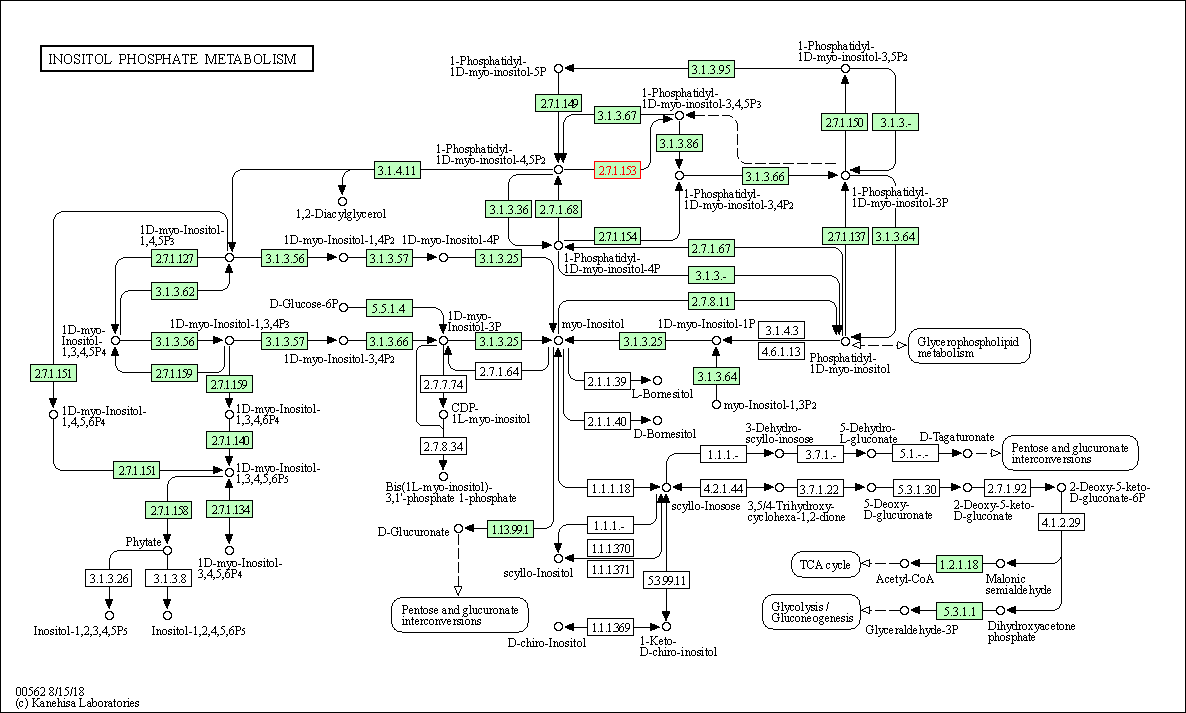
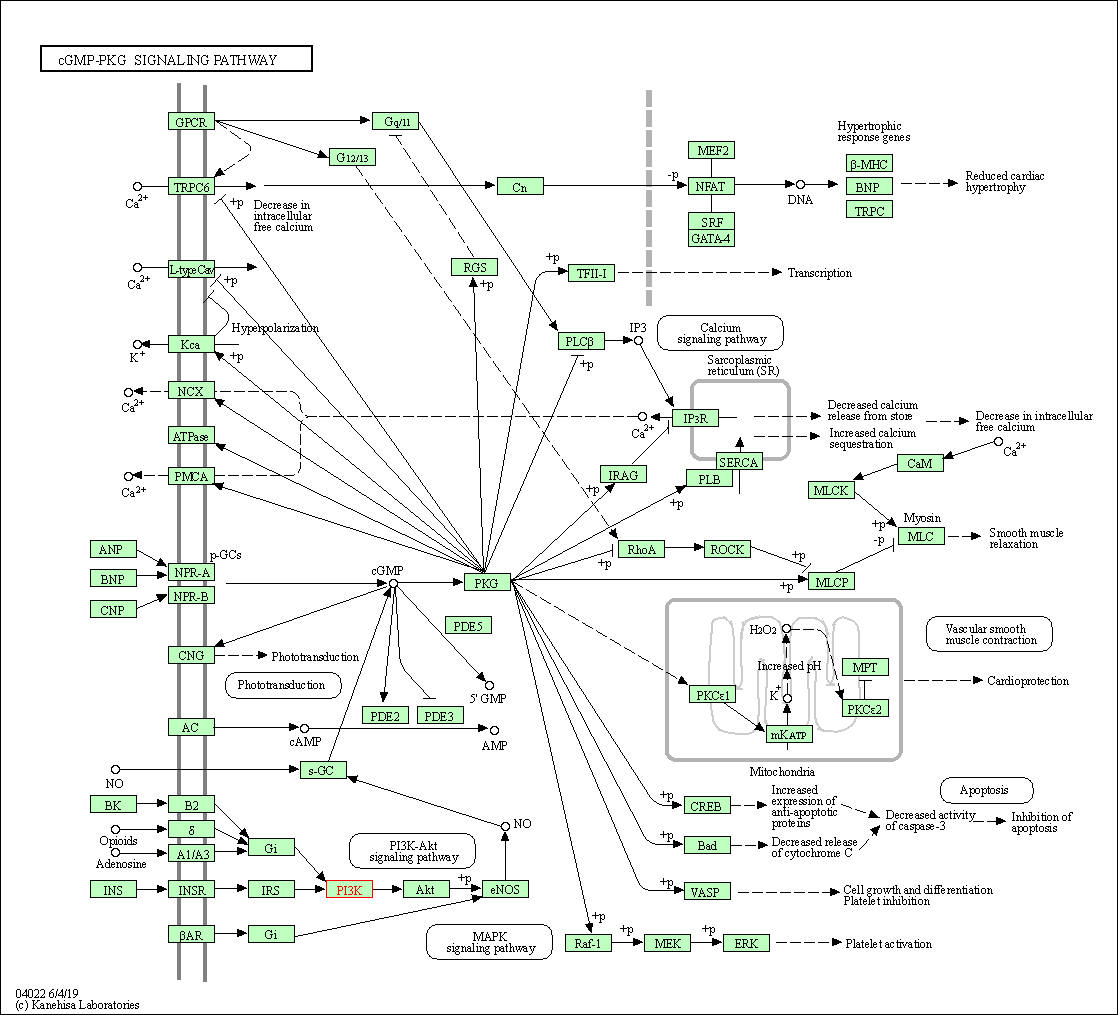
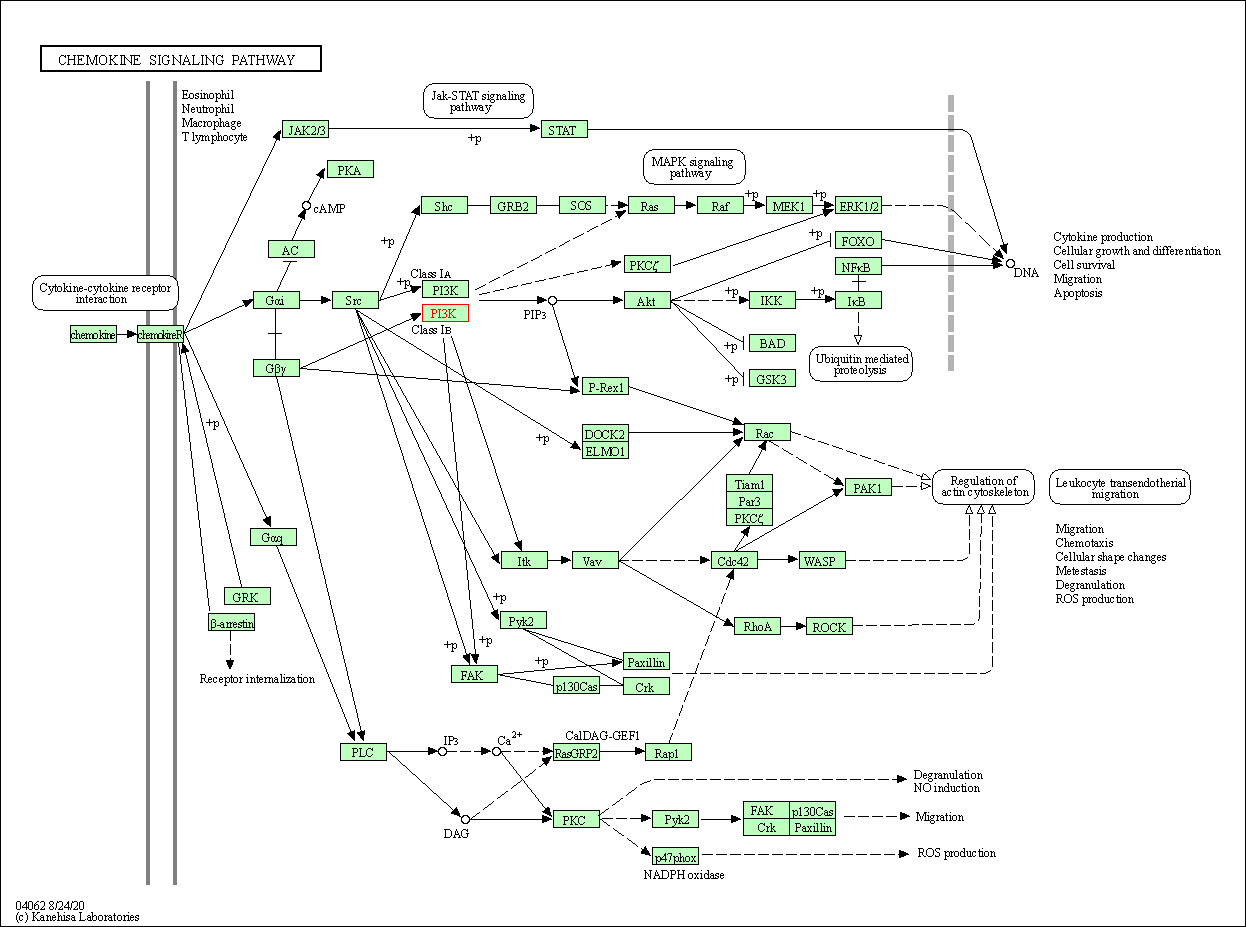
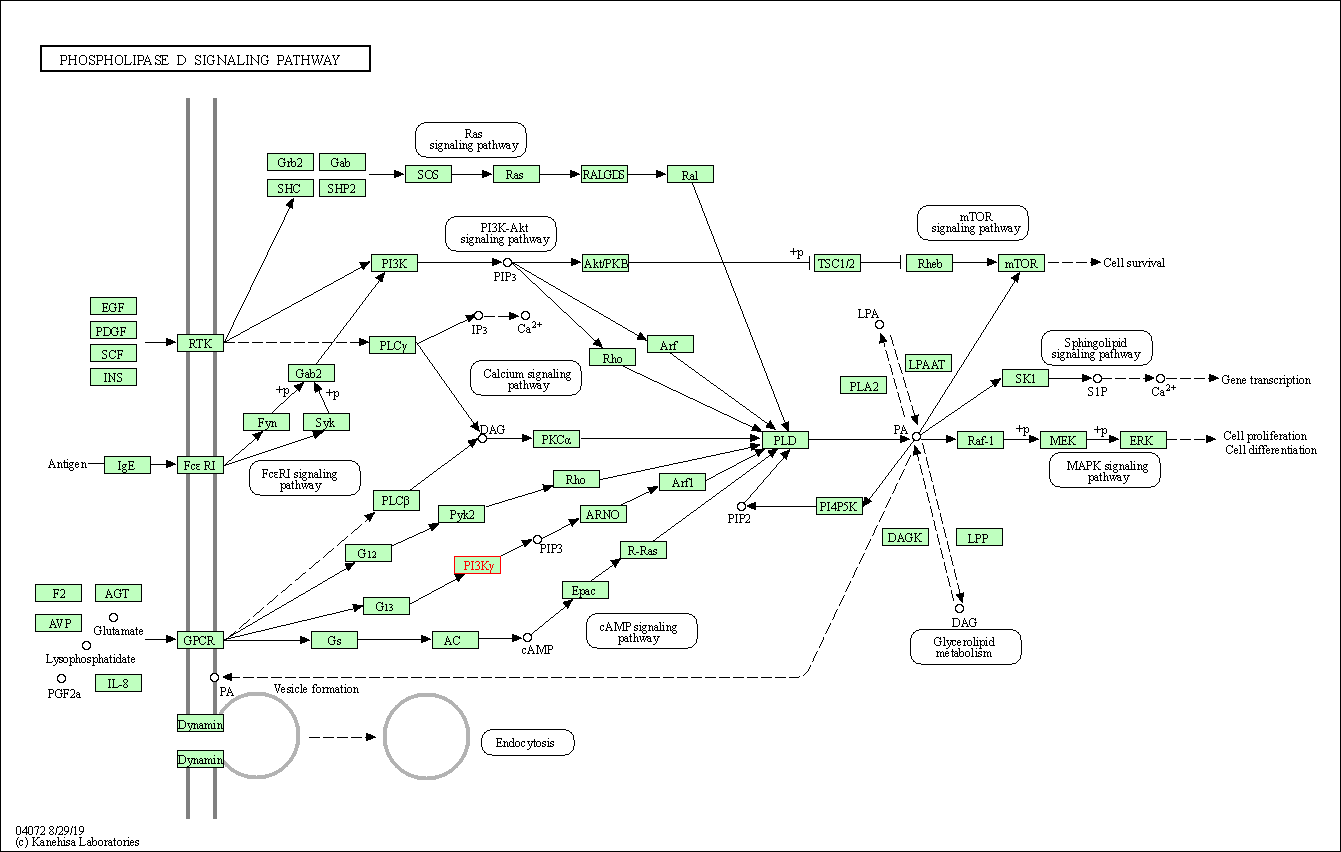
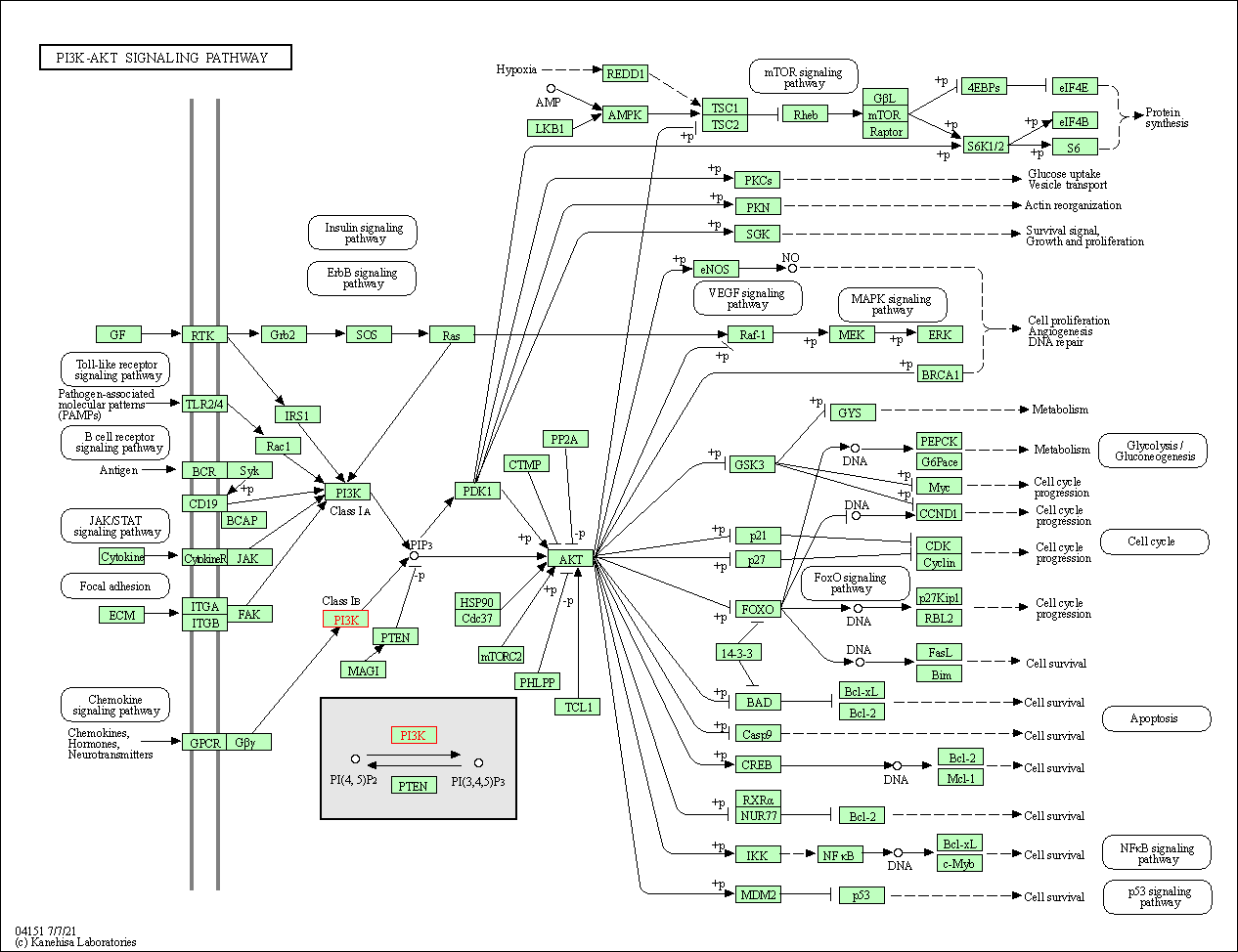
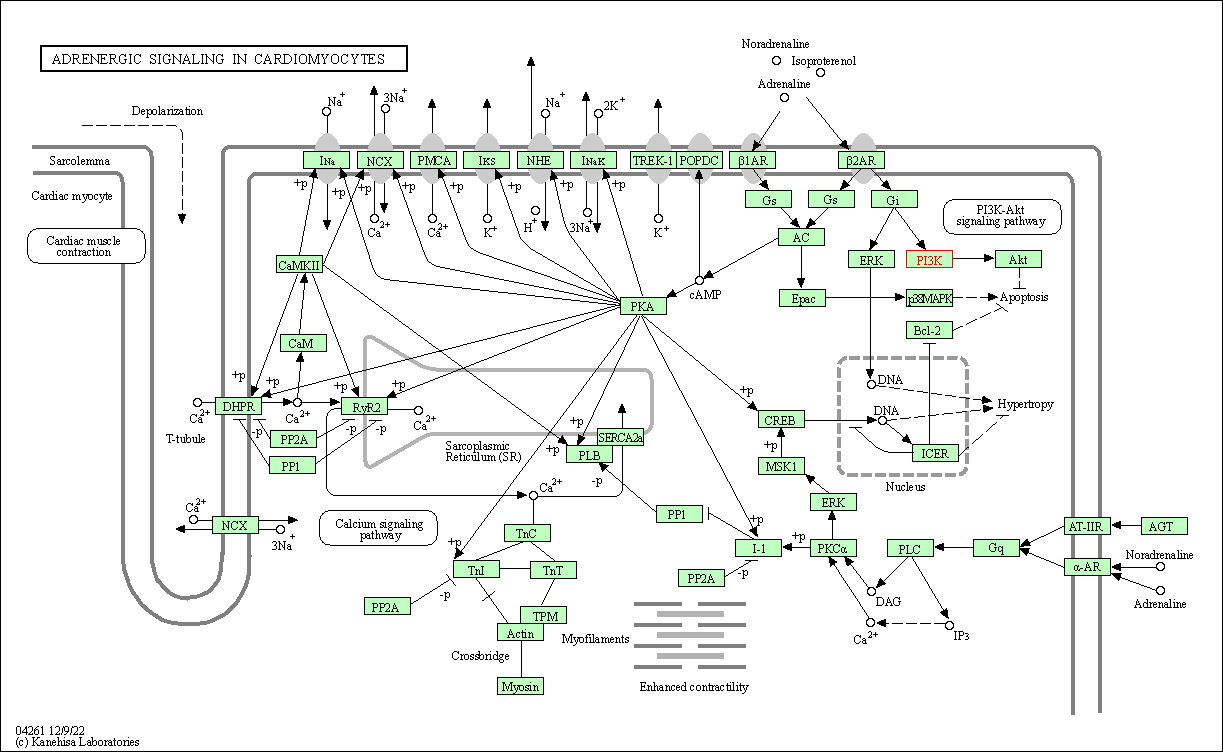



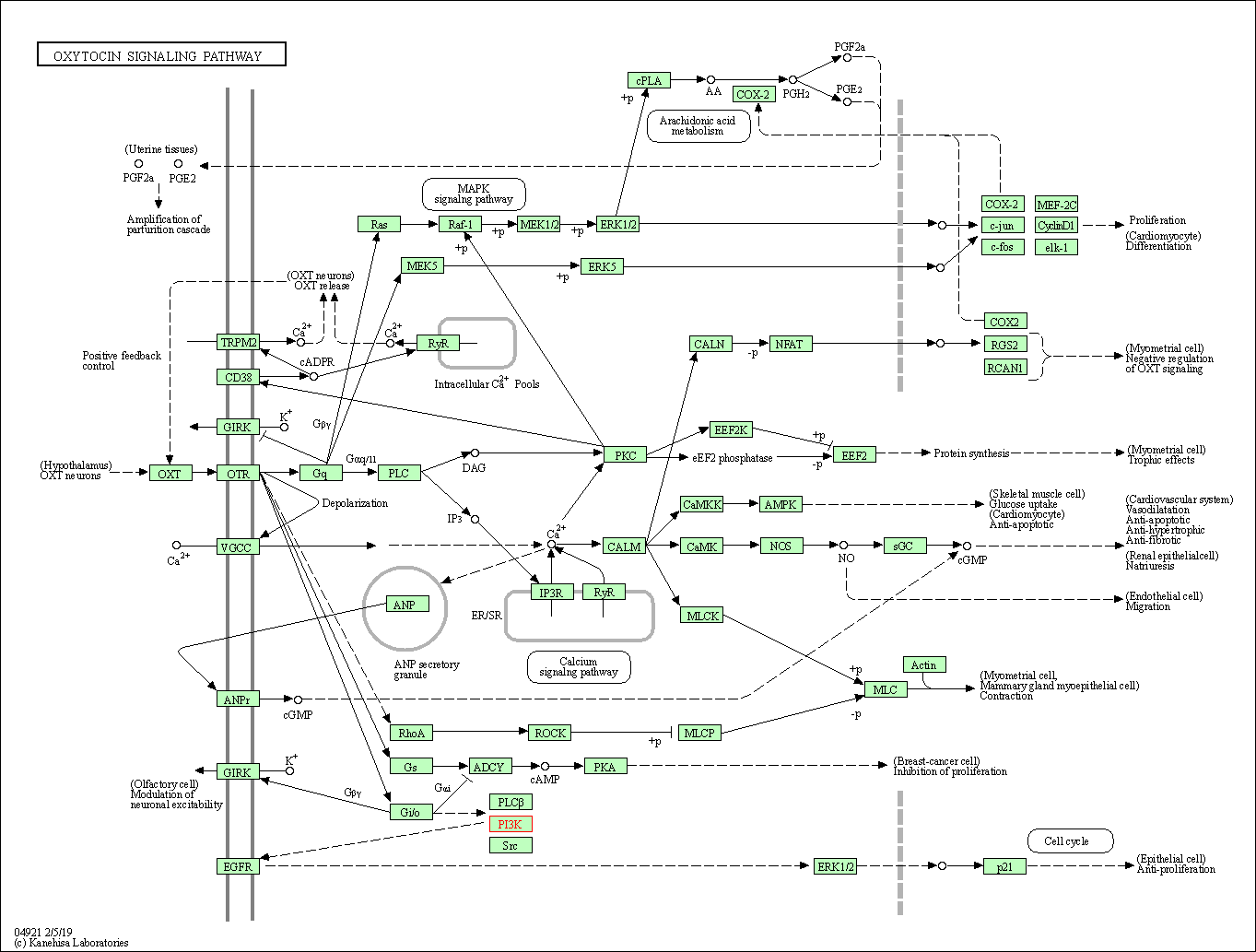
| KEGG Pathway | Pathway ID | Affiliated Target | Pathway Map |
|---|---|---|---|
| Inositol phosphate metabolism | hsa00562 | Affiliated Target |

|
| Class: Metabolism => Carbohydrate metabolism | Pathway Hierarchy | ||
| cGMP-PKG signaling pathway | hsa04022 | Affiliated Target |

|
| Class: Environmental Information Processing => Signal transduction | Pathway Hierarchy | ||
| Chemokine signaling pathway | hsa04062 | Affiliated Target |

|
| Class: Organismal Systems => Immune system | Pathway Hierarchy | ||
| Phospholipase D signaling pathway | hsa04072 | Affiliated Target |

|
| Class: Environmental Information Processing => Signal transduction | Pathway Hierarchy | ||
| PI3K-Akt signaling pathway | hsa04151 | Affiliated Target |

|
| Class: Environmental Information Processing => Signal transduction | Pathway Hierarchy | ||
| Adrenergic signaling in cardiomyocytes | hsa04261 | Affiliated Target |

|
| Class: Organismal Systems => Circulatory system | Pathway Hierarchy | ||
| Apelin signaling pathway | hsa04371 | Affiliated Target |

|
| Class: Environmental Information Processing => Signal transduction | Pathway Hierarchy | ||
| Platelet activation | hsa04611 | Affiliated Target |

|
| Class: Organismal Systems => Immune system | Pathway Hierarchy | ||
| Cholinergic synapse | hsa04725 | Affiliated Target |

|
| Class: Organismal Systems => Nervous system | Pathway Hierarchy | ||
| Oxytocin signaling pathway | hsa04921 | Affiliated Target |

|
| Class: Organismal Systems => Endocrine system | Pathway Hierarchy | ||
| Click to Show/Hide the Information of Affiliated Human Pathways | |||
| Degree | 19 | Degree centrality | 2.04E-03 | Betweenness centrality | 1.90E-03 |
|---|---|---|---|---|---|
| Closeness centrality | 2.39E-01 | Radiality | 1.42E+01 | Clustering coefficient | 1.11E-01 |
| Neighborhood connectivity | 4.09E+01 | Topological coefficient | 8.64E-02 | Eccentricity | 12 |
| Download | Click to Download the Full PPI Network of This Target | ||||
| Chemical Structure based Activity Landscape of Target | Top |
|---|---|
| Drug Property Profile of Target | Top | |
|---|---|---|
| (1) Molecular Weight (mw) based Drug Clustering | (2) Octanol/Water Partition Coefficient (xlogp) based Drug Clustering | |
|
|
||
| (3) Hydrogen Bond Donor Count (hbonddonor) based Drug Clustering | (4) Hydrogen Bond Acceptor Count (hbondacc) based Drug Clustering | |
|
|
||
| (5) Rotatable Bond Count (rotbonds) based Drug Clustering | (6) Topological Polar Surface Area (polararea) based Drug Clustering | |
|
|
||
| "RO5" indicates the cutoff set by lipinski's rule of five; "D123AB" colored in GREEN denotes the no violation of any cutoff in lipinski's rule of five; "D123AB" colored in PURPLE refers to the violation of only one cutoff in lipinski's rule of five; "D123AB" colored in BLACK represents the violation of more than one cutoffs in lipinski's rule of five | ||
| Co-Targets | Top | |||||
|---|---|---|---|---|---|---|
| Co-Targets | ||||||
| Target Poor or Non Binders | Top | |||||
|---|---|---|---|---|---|---|
| Target Poor or Non Binders | ||||||
| Target Regulators | Top | |||||
|---|---|---|---|---|---|---|
| Target-regulating microRNAs | ||||||
| Target-interacting Proteins | ||||||
| Target Profiles in Patients | Top | |||||
|---|---|---|---|---|---|---|
| Target Expression Profile (TEP) |
||||||
| Target-Related Models and Studies | Top | |||||
|---|---|---|---|---|---|---|
| Target Validation | ||||||
| References | Top | |||||
|---|---|---|---|---|---|---|
| REF 1 | PI3K-delta and PI3K-gamma inhibition by IPI-145 abrogates immune responses and suppresses activity in autoimmune and inflammatory disease models. Chem Biol. 2013 Nov 21;20(11):1364-74. | |||||
| REF 2 | 2017 FDA drug approvals.Nat Rev Drug Discov. 2018 Feb;17(2):81-85. | |||||
| REF 3 | 2018 FDA drug approvals.Nat Rev Drug Discov. 2019 Feb;18(2):85-89. | |||||
| REF 4 | URL: http://www.guidetopharmacology.org Nucleic Acids Res. 2015 Oct 12. pii: gkv1037. The IUPHAR/BPS Guide to PHARMACOLOGY in 2016: towards curated quantitative interactions between 1300 protein targets and 6000 ligands. (Ligand id: 7878). | |||||
| REF 5 | ClinicalTrials.gov (NCT01610284) Phase III Study of BKM120/Placebo With Fulvestrant in Postmenopausal Patients With Hormone Receptor Positive HER2-negative Locally Advanced or Metastatic Breast Cancer Refractory to Aromatase Inhibitor. U.S. National Institutes of Health. | |||||
| REF 6 | URL: http://www.guidetopharmacology.org Nucleic Acids Res. 2015 Oct 12. pii: gkv1037. The IUPHAR/BPS Guide to PHARMACOLOGY in 2016: towards curated quantitative interactions between 1300 protein targets and 6000 ligands. (Ligand id: 5693). | |||||
| REF 7 | The oral protein-kinase C beta inhibitor enzastaurin (LY317615) suppresses signalling through the AKT pathway, inhibits proliferation and induces apoptosis in multiple myeloma cell lines. Leuk Lymphoma. 2008 Jul;49(7):1374-83. | |||||
| REF 8 | Emerging therapies for multiple myeloma. Expert Opin Emerg Drugs. 2009 Mar;14(1):99-127. | |||||
| REF 9 | Clinical pipeline report, company report or official report of the Pharmaceutical Research and Manufacturers of America (PhRMA) | |||||
| REF 10 | URL: http://www.guidetopharmacology.org Nucleic Acids Res. 2015 Oct 12. pii: gkv1037. The IUPHAR/BPS Guide to PHARMACOLOGY in 2016: towards curated quantitative interactions between 1300 protein targets and 6000 ligands. (Ligand id: 7833). | |||||
| REF 11 | Phase I study of oral rigosertib (ON 01910.Na), a dual inhibitor of the PI3K and Plk1 pathways, in adult patients with advanced solid malignancies. Clin Cancer Res. 2014 Mar 15;20(6):1656-65. | |||||
| REF 12 | ClinicalTrials.gov (NCT04187508) A Phase IIa, Double-Blind, Randomized, Parallel Group, Placebo-Controlled Multi-Centre Study to Evaluate the Effect of AZD8154 Administered Via Nebulizer Once Daily on Allergen-Induced Inflammation in Subjects With Mild Allergic Asthma Challenged With an Inhaled Allergen. U.S.National Institutes of Health. | |||||
| REF 13 | URL: http://www.guidetopharmacology.org Nucleic Acids Res. 2015 Oct 12. pii: gkv1037. The IUPHAR/BPS Guide to PHARMACOLOGY in 2016: towards curated quantitative interactions between 1300 protein targets and 6000 ligands. (Ligand id: 7950). | |||||
| REF 14 | Trusted, scientifically sound profiles of drug programs, clinical trials, safety reports, and company deals, written by scientists. Springer. 2015. Adis Insight (drug id 800026094) | |||||
| REF 15 | ClinicalTrials.gov (NCT01778088) Open-Label Study of I-131-CLR1404 in Subjects With Recurrent Glioma. U.S. National Institutes of Health. | |||||
| REF 16 | ClinicalTrials.gov (NCT04632992) A Study Evaluating Targeted Therapies in Participants Who Have Advanced Solid Tumors With Genomic Alterations or Protein Expression Patterns Predictive of Response (MyTACTIC). U.S. National Institutes of Health. | |||||
| REF 17 | ClinicalTrials.gov (NCT03522298) Safety, Pharmacokinetics and Efficacy of Paxalisib (GDC-0084) in Newly-diagnosed Glioblastoma. U.S. National Institutes of Health. | |||||
| REF 18 | Clinical pipeline report, company report or official report of Roche. | |||||
| REF 19 | URL: http://www.guidetopharmacology.org Nucleic Acids Res. 2015 Oct 12. pii: gkv1037. The IUPHAR/BPS Guide to PHARMACOLOGY in 2016: towards curated quantitative interactions between 1300 protein targets and 6000 ligands. (Ligand id: 5682). | |||||
| REF 20 | Trusted, scientifically sound profiles of drug programs, clinical trials, safety reports, and company deals, written by scientists. Springer. 2015. Adis Insight (drug id 800027517) | |||||
| REF 21 | ClinicalTrials.gov (NCT03980041) Study to Evaluate the Efficacy/Safety of IPI-549 in Combination With Nivolumab in Patients With Advanced Urothelial Carcinoma (MARIO-275). U.S. National Institutes of Health. | |||||
| REF 22 | URL: http://www.guidetopharmacology.org Nucleic Acids Res. 2015 Oct 12. pii: gkv1037. The IUPHAR/BPS Guide to PHARMACOLOGY in 2016: towards curated quantitative interactions between 1300 protein targets and 6000 ligands. (Ligand id: 7936). | |||||
| REF 23 | ClinicalTrials.gov (NCT01430585) Pre-Operative Study of PF-4691502 With Letrozole Compared To Letrozole Alone In Patients With Early Breast Cancer. U.S. National Institutes of Health. | |||||
| REF 24 | URL: http://www.guidetopharmacology.org Nucleic Acids Res. 2015 Oct 12. pii: gkv1037. The IUPHAR/BPS Guide to PHARMACOLOGY in 2016: towards curated quantitative interactions between 1300 protein targets and 6000 ligands. (Ligand id: 7940). | |||||
| REF 25 | First-in-Human Study of PF-05212384 (PKI-587), a Small-Molecule, Intravenous, Dual Inhibitor of PI3K and mTOR in Patients with Advanced Cancer. Clin Cancer Res. 2015 Apr 15;21(8):1888-95. | |||||
| REF 26 | ClinicalTrials.gov (NCT03740100) Single-arm Study With Bimiralisib in Patients With HNSCC Harboring NOTCH1 Loss of Function Mutations (HNSCC). U.S. National Institutes of Health. | |||||
| REF 27 | URL: http://www.guidetopharmacology.org Nucleic Acids Res. 2015 Oct 12. pii: gkv1037. The IUPHAR/BPS Guide to PHARMACOLOGY in 2016: towards curated quantitative interactions between 1300 protein targets and 6000 ligands. (Ligand id: 7941). | |||||
| REF 28 | ClinicalTrials.gov (NCT01331083) A Phase II Study of PX-866 in Patients With Recurrent or Metastatic Castration Resistant Prostate Cancer. U.S. National Institutes of Health. | |||||
| REF 29 | ClinicalTrials.gov (NCT01936363) Trial of Pimasertib With SAR245409 or Placebo in Ovarian Cancer. U.S. National Institutes of Health. | |||||
| REF 30 | URL: http://www.guidetopharmacology.org Nucleic Acids Res. 2015 Oct 12. pii: gkv1037. The IUPHAR/BPS Guide to PHARMACOLOGY in 2016: towards curated quantitative interactions between 1300 protein targets and 6000 ligands. (Ligand id: 7963). | |||||
| REF 31 | Phase II study of the PI3K inhibitor pilaralisib (SAR245408; XL147) in patients with advanced or recurrent endometrial carcinoma. Gynecol Oncol. 2015 Feb;136(2):246-53. | |||||
| REF 32 | URL: http://www.guidetopharmacology.org Nucleic Acids Res. 2015 Oct 12. pii: gkv1037. The IUPHAR/BPS Guide to PHARMACOLOGY in 2016: towards curated quantitative interactions between 1300 protein targets and 6000 ligands. (Ligand id: 7951). | |||||
| REF 33 | Simultaneous targeting of PI3K and mTOR with NVP-BGT226 is highly effective in multiple myeloma. Anticancer Drugs. 2012 Jan;23(1):131-8. | |||||
| REF 34 | ClinicalTrials.gov (NCT01516905) PET/CT Imaging of Malignant Brain Tumors With a Novel Radioiodinated Phospholipid Ether Analogue 124I-NM404. U.S. National Institutes of Health. | |||||
| REF 35 | ClinicalTrials.gov (NCT02189174) Study of CLR457 Administered Orally in Adult Patients With Advanced Solid Malignancies. U.S. National Institutes of Health. | |||||
| REF 36 | ClinicalTrials.gov (NCT04278768) Dose Escalation/ Expansion Trial of CA-4948 as Monotherapy and in Combination With Azacitidine or Venetoclax in Patients With AML or MDS. U.S. National Institutes of Health. | |||||
| REF 37 | ClinicalTrials.gov (NCT04495621) MEN1611 With Cetuximab in Metastatic Colorectal Cancer (C-PRECISE-01) (C-PRECISE-01). U.S. National Institutes of Health. | |||||
| REF 38 | URL: http://www.guidetopharmacology.org Nucleic Acids Res. 2015 Oct 12. pii: gkv1037. The IUPHAR/BPS Guide to PHARMACOLOGY in 2016: towards curated quantitative interactions between 1300 protein targets and 6000 ligands. (Ligand id: 5715). | |||||
| REF 39 | Pharmacologic therapeutics for cardiac reperfusion injury. Expert Opin Emerg Drugs. 2007 Sep;12(3):367-88. | |||||
| REF 40 | ClinicalTrials.gov (NCT05269940) A Phase I/II Study Evaluating ZX-101A in Patients With Relapsed/Refractory Hematological Malignancies. U.S.National Institutes of Health. | |||||
| REF 41 | URL: http://www.guidetopharmacology.org Nucleic Acids Res. 2015 Oct 12. pii: gkv1037. The IUPHAR/BPS Guide to PHARMACOLOGY in 2016: towards curated quantitative interactions between 1300 protein targets and 6000 ligands. (Ligand id: 8527). | |||||
| REF 42 | ClinicalTrials.gov (NCT01884285) AZD8186 First Time In Patient Ascending Dose Study. U.S. National Institutes of Health. | |||||
| REF 43 | Trusted, scientifically sound profiles of drug programs, clinical trials, safety reports, and company deals, written by scientists. Springer. 2015. Adis Insight (drug id 800034336) | |||||
| REF 44 | Dual PI3K/mTOR inhibitors, GSK2126458 and PKI-587, suppress tumor progression and increase radiosensitivity in nasopharyngeal carcinoma. Mol Cancer Ther. 2015 Feb;14(2):429-39. | |||||
| REF 45 | ClinicalTrials.gov (NCT02337309) SF1126 for Patients With Relapsed or Refractory Neuroblastoma. U.S. National Institutes of Health. | |||||
| REF 46 | ClinicalTrials.gov (NCT01762410) Clinical Study of Oral PI3K/mTOR Inhibitor in Patients With Advanced Refractory Solid Tumors. U.S. National Institutes of Health. | |||||
| REF 47 | URL: http://www.guidetopharmacology.org Nucleic Acids Res. 2015 Oct 12. pii: gkv1037. The IUPHAR/BPS Guide to PHARMACOLOGY in 2016: towards curated quantitative interactions between 1300 protein targets and 6000 ligands. (Ligand id: 7424). | |||||
| REF 48 | ClinicalTrials.gov (NCT00019656) Perifosine in Treating Patients With Refractory Solid Tumors or Hematologic Cancer. U.S. National Institutes of Health. | |||||
| REF 49 | URL: http://www.guidetopharmacology.org Nucleic Acids Res. 2015 Oct 12. pii: gkv1037. The IUPHAR/BPS Guide to PHARMACOLOGY in 2016: towards curated quantitative interactions between 1300 protein targets and 6000 ligands. (Ligand id: 8382). | |||||
| REF 50 | VS-5584, a novel and highly selective PI3K/mTOR kinase inhibitor for the treatment of cancer. Mol Cancer Ther. 2013 Feb;12(2):151-61. | |||||
| REF 51 | URL: http://www.guidetopharmacology.org Nucleic Acids Res. 2015 Oct 12. pii: gkv1037. The IUPHAR/BPS Guide to PHARMACOLOGY in 2016: towards curated quantitative interactions between 1300 protein targets and 6000 ligands. (Ligand id: 7965). | |||||
| REF 52 | Combination of the PI3K inhibitor ZSTK474 with a PSMA-targeted immunotoxin accelerates apoptosis and regression of prostate cancer. Neoplasia. 2013 Oct;15(10):1172-83. | |||||
| REF 53 | Trusted, scientifically sound profiles of drug programs, clinical trials, safety reports, and company deals, written by scientists. Springer. 2015. Adis Insight (drug id 800018893) | |||||
| REF 54 | Trusted, scientifically sound profiles of drug programs, clinical trials, safety reports, and company deals, written by scientists. Springer. 2015. Adis Insight (drug id 800028447) | |||||
| REF 55 | Trusted, scientifically sound profiles of drug programs, clinical trials, safety reports, and company deals, written by scientists. Springer. 2015. Adis Insight (drug id 800028453) | |||||
| REF 56 | Trusted, scientifically sound profiles of drug programs, clinical trials, safety reports, and company deals, written by scientists. Springer. 2015. Adis Insight (drug id 800022134) | |||||
| REF 57 | URL: http://www.guidetopharmacology.org Nucleic Acids Res. 2015 Oct 12. pii: gkv1037. The IUPHAR/BPS Guide to PHARMACOLOGY in 2016: towards curated quantitative interactions between 1300 protein targets and 6000 ligands. (Ligand id: 6060). | |||||
| REF 58 | Trusted, scientifically sound profiles of drug programs, clinical trials, safety reports, and company deals, written by scientists. Springer. 2015. Adis Insight (drug id 800007058) | |||||
| REF 59 | BAY 80-6946 is a highly selective intravenous PI3K inhibitor with potent p110 and p110 activities in tumor cell lines and xenograft models.Mol Cancer Ther.2013 Nov;12(11):2319-30. | |||||
| REF 60 | Targeting the phosphoinositide 3-kinase pathway in cancer. Nat Rev Drug Discov. 2009 Aug;8(8):627-44. | |||||
| REF 61 | Phase I study of Rigosertib, an inhibitor of the phosphatidylinositol 3-kinase and Polo-like kinase 1 pathways, combined with gemcitabine in patients with solid tumors and pancreatic cancer.Clin Cancer Res.2012 Apr 1;18(7):2048-55. | |||||
| REF 62 | Discovery of AZD8154, a Dual PI3Kgamma-delta Inhibitor for the Treatment of Asthma. J Med Chem. 2021 Jun 24;64(12):8053-8075. | |||||
| REF 63 | The dual PI3K/mTOR inhibitor NVP-BEZ235 is a potent inhibitor of ATM- and DNA-PKCs-mediated DNA damage responses. Neoplasia. 2012 Jan;14(1):34-43. | |||||
| REF 64 | URL: http://www.guidetopharmacology.org Nucleic Acids Res. 2015 Oct 12. pii: gkv1037. The IUPHAR/BPS Guide to PHARMACOLOGY in 2016: towards curated quantitative interactions between 1300 protein targets and 6000 ligands. (Target id: 2155). | |||||
| REF 65 | Current clinical development of PI3K pathway inhibitors in glioblastoma. Neuro Oncol. 2012 July; 14(7): 819-829. | |||||
| REF 66 | GDC-0980 is a novel class I PI3K/mTOR kinase inhibitor with robust activity in cancer models driven by the PI3K pathway. Mol Cancer Ther. 2011 Dec;10(12):2426-36. | |||||
| REF 67 | The PI3K/Akt pathway as a target in the treatment of hematologic malignancies. Anticancer Agents Med Chem. 2009 Jun;9(5):550-9. | |||||
| REF 68 | Clinical pipeline report, company report or official report of the Pharmaceutical Research and Manufacturers of America (PhRMA) | |||||
| REF 69 | PF-04691502, a potent and selective oral inhibitor of PI3K and mTOR kinases with antitumor activity.Mol Cancer Ther.2011 Nov;10(11):2189-99. | |||||
| REF 70 | URL: http://www.guidetopharmacology.org Nucleic Acids Res. 2015 Oct 12. pii: gkv1037. The IUPHAR/BPS Guide to PHARMACOLOGY in 2016: towards curated quantitative interactions between 1300 protein targets and 6000 ligands. (Target id: 2156). | |||||
| REF 71 | Clinical pipeline report, company report or official report of Sanofi Oncology. | |||||
| REF 72 | An integrin-targeted, pan-isoform, phosphoinositide-3 kinase inhibitor, SF1126, has activity against multiple myeloma in vivo.Cancer Chemother Pharmacol.2013 Apr;71(4):867-81. | |||||
| REF 73 | Pan-PI-3 kinase inhibitor SF1126 shows antitumor and antiangiogenic activity in renal cell carcinoma.Cancer Chemother Pharmacol. 2015 Mar;75(3):595-608. | |||||
| REF 74 | The Selective PI3K Inhibitor XL147 (SAR245408) Inhibits Tumor Growth and Survival and Potentiates the Activity of Chemotherapeutic Agents in Preclinical Tumor Models.Mol Cancer Ther.2015 Apr;14(4):931-40. | |||||
| REF 75 | Interpreting expression profiles of cancers by genome-wide survey of breadth of expression in normal tissues. Genomics 2005 Aug;86(2):127-41. | |||||
| REF 76 | Cancer network disruption by a single molecule inhibitor targeting both histone deacetylase activity and phosphatidylinositol 3-kinase signaling.Clin Cancer Res.2012 Aug 1;18(15):4104-13. | |||||
| REF 77 | Company report (Chugai-pharm) | |||||
| REF 78 | Aerosolized phosphoinositide 3-kinase gamma/delta inhibitor TG100-115 [3-[2,4-diamino-6-(3-hydroxyphenyl)pteridin-7-yl]phenol] as a therapeutic can... J Pharmacol Exp Ther. 2009 Mar;328(3):758-65. | |||||
| REF 79 | Isoform-selective PI3K inhibitors as novel therapeutics for the treatment of acute myocardial infarction. Biochem Soc Trans. 2007 Apr;35(Pt 2):204-6. | |||||
| REF 80 | PI3Kgamma inhibition: towards an 'aspirin of the 21st century' Nat Rev Drug Discov. 2006 Nov;5(11):903-18. | |||||
| REF 81 | Clinical pipeline report, company report or official report of Zenshine Pharmaceuticals | |||||
| REF 82 | Antitumor activity and induction of TP53-dependent apoptosis toward ovarian clear cell adenocarcinoma by the dual PI3K/mTOR inhibitor DS-7423. PLoS One. 2014 Feb 4;9(2):e87220. | |||||
| REF 83 | Company report (GSK) | |||||
| REF 84 | Clinical pipeline report, company report or official report of Genentech (2009). | |||||
| REF 85 | How many drug targets are there Nat Rev Drug Discov. 2006 Dec;5(12):993-6. | |||||
| REF 86 | Company report (Aezsinc) | |||||
| REF 87 | Insulinotropic agent ID-1101 (4-hydroxyisoleucine) activates insulin signaling in rat.Am J Physiol Endocrinol Metab.2004 Sep;287(3):E463-71. | |||||
| REF 88 | Pharmacologic profiling of phosphoinositide 3-kinase inhibitors as mitigators of ionizing radiation-induced cell death. J Pharmacol Exp Ther. 2013 Dec;347(3):669-80. | |||||
| REF 89 | Early detection of response to experimental chemotherapeutic Top216 with [18F]FLT and [18F]FDG PET in human ovary cancer xenografts in mice. PLoS One. 2010 Sep 24;5(9):e12965. | |||||
| REF 90 | Phosphatidylinositol 3-kinase/Akt signaling in the response of vascular endothelium to ionizing radiation. Cancer Res. 2002 Aug 15;62(16):4671-7. | |||||
| REF 91 | Estrogen regulation of c-fos gene expression through phosphatidylinositol-3-kinase-dependent activation of serum response factor in MCF-7 breast cancer cells. Biochem Biophys Res Commun. 2002 Jun 7;294(2):384-94. | |||||
| REF 92 | Synthesis and biological evaluation of sulfonylhydrazone-substituted imidazo[1,2-a]pyridines as novel PI3 kinase p110alpha inhibitors. Bioorg Med Chem. 2007 Sep 1;15(17):5837-44. | |||||
| REF 93 | The Protein Data Bank. Nucleic Acids Res. 2000 Jan 1;28(1):235-42. | |||||
| REF 94 | Blockade of PI3Kgamma suppresses joint inflammation and damage in mouse models of rheumatoid arthritis. Nat Med. 2005 Sep;11(9):936-43. | |||||
| REF 95 | A selective inhibitor reveals PI3Kgamma dependence of T(H)17 cell differentiation. Nat Chem Biol. 2012 Apr 29;8(6):576-82. | |||||
| REF 96 | LY294002-geldanamycin heterodimers as selective inhibitors of the PI3K and PI3K-related family. Bioorg Med Chem Lett. 2001 Apr 9;11(7):909-13. | |||||
| REF 97 | Development of a peptide-drug conjugate for prostate cancer therapy. Mol Pharm. 2011 Jun 6;8(3):901-12. | |||||
| REF 98 | Design and synthesis of imidazopyridine analogues as inhibitors of phosphoinositide 3-kinase signaling and angiogenesis. J Med Chem. 2011 Apr 14;54(7):2455-66. | |||||
| REF 99 | 1-substituted (Dibenzo[b,d]thiophen-4-yl)-2-morpholino-4H-chromen-4-ones endowed with dual DNA-PK/PI3-K inhibitory activity. J Med Chem. 2013 Aug 22;56(16):6386-401. | |||||
| REF 100 | Discovery of the Highly Potent PI3K/mTOR Dual Inhibitor PF-04979064 through Structure-Based Drug Design. ACS Med Chem Lett. 2012 Nov 7;4(1):91-7. | |||||
| REF 101 | Inactivation of PI(3)K p110delta breaks regulatory T-cell-mediated immune tolerance to cancer. Nature. 2014 Jun 19;510(7505):407-11. | |||||
| REF 102 | Lead optimization of N-3-substituted 7-morpholinotriazolopyrimidines as dual phosphoinositide 3-kinase/mammalian target of rapamycin inhibitors: di... J Med Chem. 2010 Jan 28;53(2):798-810. | |||||
| REF 103 | Targeted polypharmacology: discovery of dual inhibitors of tyrosine and phosphoinositide kinases. Nat Chem Biol. 2008 Nov;4(11):691-9. | |||||
| REF 104 | PI 3-kinase p110beta: a new target for antithrombotic therapy. Nat Med. 2005 May;11(5):507-14. | |||||
| REF 105 | Discovery and SAR of Novel 2,3-Dihydroimidazo[1,2-c]quinazoline PI3K Inhibitors: Identification of Copanlisib (BAY 80-6946). ChemMedChem. 2016 Jul 19;11(14):1517-30. | |||||
| REF 106 | Identification and characterization of NVP-BKM120, an orally available pan-class I PI3-kinase inhibitor. Mol Cancer Ther. 2012 Feb;11(2):317-28. | |||||
If You Find Any Error in Data or Bug in Web Service, Please Kindly Report It to Dr. Zhou and Dr. Zhang.

